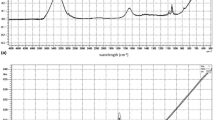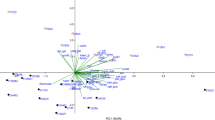Abstract
The present study aims to analyse the evolution of colour and browning of fortified wines submitted to oak and accelerated ageing induced by temperature, both traditional ageing processes of Madeira wines. These wines were followed during the first 2 years of ageing and were simultaneously compared to aged reference samples, in order to disclose if accelerated ageing favours the wine evolution. The data analysis approaches followed two strategies: the first one was based on the monitoring of wine colour parameters based on CIELab methodology, while the second strategy adopted an untargeted approach, taking advantage of all wine information comprised on the UV-vis spectrum. CIELab results indicated that the greatest variation (up to 92 %) occurs during the vinification, since it was observed that wines produced from the same grape variety (Tinta Negra) acquired different characteristics already on the vinification processes. All wines tend to approach the reference samples during ageing, with the lowest ΔE* value obtained for Malvasia submitted to canteiro at 2 years of ageing (3.29 units). Sweet Tinta Negra wines, previously submitted to estufagem, presented the most pronounced colour change associated with ageing. The multivariate principal component analysis (PCA) model was built with aged reference samples to evaluate how young wines acquire the reference wine’s characteristics and revealed that accelerated ageing increases colour evolution and favours the homogeneity of Malvasia wines.






Similar content being viewed by others
References
Arvanitoyannis, I. S., Katsota, M. N., Psarra, E. P., Soufleros, E. H., & Kallithraka, S. (1999). Application of quality control methods for assessing wine authenticity: use of multivariate analysis (chemometrics). Trends in Food Science & Technology, 10(10), 321–336.
Birse MJ (2007) The colour of red wine. PhD thesis, School of Agriculture, Food & Wine. Faculty of Science, University of Adelaide, Australia
Câmara, J. S., Marques, J. C., & Ferreira, A. C. (2003). Heterocyclic acetals in Madeira wines. Analytical and Bioanalytical Chemistry, 375(8), 1221–1224.
Câmara, J. S., Marques, J. C., Alves, M. A., & Ferreira, A. C. S. (2004). 3-Hydroxy-4,5-dimethyl-2(5H)-furanone levels in fortified Madeira wines: relationship to sugar content. Journal of Agricultural and Food Chemistry, 52, 6765–6769.
Faber, N. K. M. (1999). Multivariate sensitivity for the interpretation of the effect of spectral pretreatment methods on near-infrared calibration model predictions. Analytical Chemistry, 71(3), 557–565.
Fernández-Zurbano, P., Ferreira, V., Escudero, A., & Cacho, J. (1998). Role of hydroxycinnamic acids and flavanols in the oxidation and browning of white wines. Journal of Agricultural and Food Chemistry, 46(12), 4937–4944.
Figueiredo-González, M., Cancho-Grande, B., & Simal-Gándara, J. (2013). Garnacha tintorera-based sweet wines: chromatic properties and global phenolic composition by means of UV–Vis spectrophotometry. Food Chemistry, 140(1–2), 217–224.
Gómez, E., Martínez, A., & Laencina, J. (1995). Prevention of oxidative browning during wine storage. Food Research International, 28(3), 213–217.
Gómez-Míguez, M., González-Miret, M. L., & Heredia, F. J. (2007). Evolution of colour and anthocyanin composition of Syrah wines elaborated with pre-fermentative cold maceration. Journal of Food Engineering, 79(1), 271–278.
HunterLab (2008). CIE L*a*b* color scale. Available at http://www.hunterlab.com/appnotes/an07_96a.pdf. Assessed 15 Oct 2014.
Karbowiak, T., Gougeon, R. D., Alinc, J. B., Brachais, L., Debeaufort, F., Voilley, A., & Chassagne, D. (2010). Wine oxidation and the role of cork. Critical Reviews in Food Science and Nutrition, 50(1), 20–52.
Li, H., Guo, A., & Wang, H. (2008). Mechanisms of oxidative browning of wine. Food Chemistry, 108(1), 1–13.
Lopez-Toledano, A., Mayen, M., Merida, J., & Medina, M. (2006). Yeasts used to delay browning in white wines. Food Chemistry, 97(3), 498–504.
Mayén, M., Barón, R., Mérida, J., & Medina, M. (1997). Changes in phenolic compounds during accelerated browning in white wines from cv. Pedro ximenez and cv. Baladi grapes. Food Chemistry, 58(I-2), 89–95.
Montgomery, D. (2001). Introduction to statistical quality control. 4 th ed. John Wiley & Sons Canada, Ltd.
Næs, T., Isaksson, T., Fearn, T., & Davies, T. (2002). A user-friendly guide to multivariate calibration and classification. Chichester: NIR Publications.
OIV (2006). Détermination des caractéristiques chromatiques selon Cielab (Résolution Oeno 1/2006). In: OIV (ed), vol Méthode OIV-MA-AS2-11.
Oliveira, C. M., Ferreira, A. C. S., Freitas, V. D., & Silva, A. M. S. (2011). Oxidation mechanisms occurring in wines. Food Research International, 44(5), 1115–1126.
Pereira, V. (2011). Effect of the estufagem process on the chemical constituents of Madeira wines. PhD thesis, University of Madeira.
Pereira, A. C., Reis, M. S., Saraiva, P. M., & Marques, J. C. (2011a). Development of a fast and reliable method for long- and short-term wine age prediction. Talanta, 86, 293–304.
Pereira, V., Albuquerque, F. M., Ferreira, A. C., Cacho, J., & Marques, J. C. (2011b). Evolution of 5-hydroxymethylfurfural (HMF) and furfural (F) in fortified wines submitted to overheating conditions. Food Research International, 44, 71–76.
Pereira, V., Albuquerque, F., Cacho, J., & Marques, J. (2013). Polyphenols, antioxidant potential and color of fortified wines during accelerated ageing: the Madeira wine case study. Molecules, 18(3), 2997–3017.
Pérez-Magariño, S., & González-Sanjosé, M. L. (2003). Application of absorbance values used in wineries for estimating CIELab parameters in red wines. Food Chemistry, 81(2), 301–306.
Ribéreau-Gayon, P., Glories, Y., Maujean, A. & Dubourdieu, D. (2006). Phenolic compounds. In: Handbook of enology. John Wiley & Sons, Ltd. pp 141–203.
Rinnan, Å., Berg, F. V. D., & Engelsen, S. B. (2009). Review of the most common pre-processing techniques for near-infrared spectra. Trends in Analytical Chemistry, 28(10), 1201–1222.
Sant'Anna, V., Gurak, P. D., Ferreira Marczak, L. D., & Tessaro, I. C. (2013). Tracking bioactive compounds with colour changes in foods—a review. Dyes and Pigments, 98(3), 601–608.
Saurina, J. (2010). Characterization of wines using compositional profiles and chemometrics. TrAC Trends in Analytical Chemistry, 29(3), 234–245.
Serra-Cayuela, A., Aguilera-Curiel, M. A., Riu-Aumatell, M., Buxaderas, S., & López-Tamames, E. (2013). Browning during biological aging and commercial storage of Cava sparkling wine and the use of 5-HMF as a quality marker. Food Research International, 53(1), 226–231.
Serratosa, M. P., Lopez-Toledano, A., Medina, M., & Merida, J. (2011). Characterisation of the colour fraction of Pedro Ximenez Andalusian sweet wines. South African Journal of Enology and Viticulture, 32(1), 155–163.
Sioumis, N., Kallithraka, S., Tsoutsouras, E., Makris, D. P., & Kefalas, P. (2005). Browning development in white wines: dependence on compositional parameters and impact on antioxidant characteristics. European Food Research and Technology, 220(3–4), 326–330.
Skouroumounis, G. K., Kwiatkowski, M. J., Francis, I. L., Oakey, H., Capone, D. L., Peng, Z., Duncan, B., Sefton, M. A., & Waters, E. J. (2005). The influence of ascorbic acid on the composition, colour and flavour properties of a Riesling and a wooded Chardonnay wine during five years' storage. Australian Journal of Grape and Wine Research, 11(3), 355–368.
Acknowledgments
The authors acknowledge the financial support given by FEDER through +Conhecimento and COMPETE programmes and national funds of FCT (Fundação para a Ciência e Tecnologia): project IMPACT II (MADFDR-01-0190-FEDER-000010), project ESTUFA (PTDC/EQU-EPR/114685/2009, PEst-C/CTM/LA0025/2011) and ARDITI—Agência Regional para o Desenvolvimento da Investigação, Tecnologia e Inovação.
Author information
Authors and Affiliations
Corresponding author
Rights and permissions
About this article
Cite this article
Carvalho, M.J., Pereira, V., Pereira, A.C. et al. Evaluation of Wine Colour Under Accelerated and Oak-Cask Ageing Using CIELab and Chemometric Approaches. Food Bioprocess Technol 8, 2309–2318 (2015). https://doi.org/10.1007/s11947-015-1585-x
Received:
Accepted:
Published:
Issue Date:
DOI: https://doi.org/10.1007/s11947-015-1585-x




